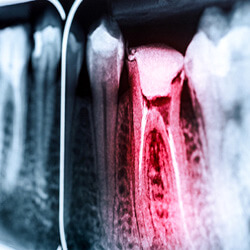Root Canal Treatment – Chaska, MN
Soothing & Saving Your Hurting Tooth
If you experience severe dental pain, you may need root canal treatment. Despite a negative reputation, root canal therapy is truthfully not a traumatic or painful procedure. Dr. Swingdorf regularly perform this safe, conservative treatment to preserve internally damaged teeth and save them from extraction. Modern root canal treatment at our Chaska, MN dental office is a surprisingly comfortable procedure and one that can literally save your smile, so give us a call today.
Why Choose Chaska Dental Center for Root Canal Treatment?
- Relaxing Nitrous Oxide Sedation Available
- CEREC® Dental Crowns Placed in One Visit
- Numbing Medicine Given via The Wand™
Why Would I Need Root Canal Treatment?
To know why your tooth hurts, you first need to understand how each tooth is constructed. Covering the outside of a tooth is enamel, which is the hardest material in the human body. Despite its strength, enamel can be penetrated by some of nature’s smallest living organisms—bacteria.
Underneath the enamel layer is dentin, a somewhat softer and much more sensitive component of a tooth. At the core, each tooth contains pulp, commonly called the nerve, with canals leading to the root. These canals play a crucial role in dental function – they transport nutrients to the root and carry away toxins.
When damaged by a tooth fracture, deep cavity, or other trauma, the canals and pulp can become vulnerable to infection. The same bacteria that penetrate the enamel to cause a cavity can eventually migrate to the nerve where a serious infection may develop. Left untreated, this infection may cause the pulp (nerve tissue) to die. This causes pain, pressure, and ultimately, bone, gum, and tooth loss.
Other than a toothache, recognizable signs that can indicate you have an infected tooth include:
- Spontaneous aching
- Swollen gum tissue around a tooth
- A pimple-like sore on your gums near a painful tooth
- A tooth that is sensitive to hot and cold temperatures
- Severe pain when you chew or bite down
What Are My Options to Reduce Tooth Pain?
Root canal therapy has developed a reputation as something to fear or dread. However, thanks to state-of-the-art dental technology and our expert approach to emergency dentistry, we can keep you comfortable and calm throughout a root canal performed at Chaska Dental Center. To help reduce pain, we will always numb the treatment site with local anesthesia first. Additional sedation options include nitrous oxide (AKA “laughing gas”) to ease your mind and remove you from worry regarding the sights, smells, and sounds of what is going on around you. Nitrous oxide takes effect almost immediately and wears off soon after the procedure is over, and the nasal mask is removed. Combine anesthesia and sedation with our team’s gentle and friendly approach, and you will see how comfortable and painless getting a root canal can really be!
Root Canal Treatment Step-By-Step

With root canal therapy, Dr. Swingdorf can alleviate this kind of pain. In addition, root canal therapy can eliminate the infection in the early stage to preserve your tooth, prevent the need for implants or bridges, and help you avoid bone loss and the need for bone grafting.
Once you are comfortably settled in the dentist’s chair, the tooth and surrounding tissue will be anesthetized with a local anesthetic. Then, a small opening is made into the infected tooth so that your dentist can clean out the pulp chamber and attached canals. After this step is completed, the hollow space is disinfected, and a biocompatible sealer is placed. The tooth is then sealed and prepared for a crown. Dr. Swingdorf may prescribe an oral antibiotic to ensure that the infection is completed eradicated. After your appointment, you’ll be able to drive and resume your normal routine.
After a couple of weeks, you’ll return to Chaska Dental Center to have a permanent crown placed over your tooth. This will result in a beautifully restored tooth and renewed comfort and function.
Understanding the Cost of Root Canals

Anytime you are preparing to undergo a dental procedure, one of the primary concerns is cost. Knowing the price of your root canal can help you determine how best to budget for this type of treatment. Fortunately, our team at Chaska Dental Center is here to make this part of the process as stress-free as possible. Apart from discussing the treatment plan, we’ll also go over your dental insurance and other strategic ways you can save when pursuing a healthier smile.
Factors That Can Affect Root Canal Cost

There are a few specific factors that our team must consider when building a plan for your care. To provide you with the most accurate cost estimate, we’ll need to:
- Determine where the tooth is located, as this will play a role in the overall cost. Typically, molars are more expensive to treat than other teeth because of their location toward the back of the mouth.
- Decide how severe your infection or damage is, as this will allow us to determine how best to approach care. If necessary, an outside specialist may need to be brought in, which can affect the overall cost of care.
- Determine if you need any post-operative treatment, like receiving a customized dental crown, which most patients do. This will incur an additional cost because of the necessity to safeguard your treated tooth.
Is It Cheaper to Pull My Tooth?

You might wonder if it’s just easier and less expensive to extract the tooth instead of treating it, but this is not necessarily the case.
The reality is that once a tooth is removed for any reason other than it being a wisdom tooth, it must be replaced. If the socket is left vacant for a prolonged period, it can result in bone and additional tooth loss over time. By removing the tooth, you’ll need to discuss options for replacement, which can include a dental bridge, partial denture, or dental implant. Each method requires more time and money to be spent.
Also, with dentures, you’ll be required to undergo adjustments and replacements every few years, and the same can be said for dental bridges. All in all, you’ll spend more on tooth extraction and replacement than you will on a root canal.
Does Dental Insurance Cover Root Canals?

Although not all dental insurance companies offer the same benefits, there is a good chance that your plan provides coverage for root canals. In general, this type of dental service is viewed as a restorative procedure – one that insurance companies will partially cover. Depending on whether they view it as a minor or major form of treatment, they might agree to pay anywhere from 50-80% of the total cost. This can be a welcome reality if you are concerned about being able to afford your root canal.
Other Options for Making Root Canal Therapy Affordable

Even if private dental insurance is not something you can afford, there are other ways you can pay for treatment without breaking the bank. At Chaska Dental Center, we offer a 5% savings as well as additional financing options to help individuals like yourself save when needing essential oral healthcare. You can always ask a member of our team for further details.
Root Canal FAQs
How Should I Prepare Before a Root Canal?
Following your dentist’s instructions before undergoing a root canal is important. If you plan to receive nitrous oxide, you’ll want to avoid eating for several hours before your procedure; otherwise, you may experience some nausea afterward. If you will not be receiving sedation, you may find it helpful to enjoy a nutritious meal beforehand, as you may struggle to eat once your procedure is complete. You will also need to avoid tobacco products and alcohol. Another suggestion is to take an over-the-counter pain reliever before your appointment so that it helps reduce any discomfort you feel after your treatment is complete.
Is It Possible to Prevent a Root Canal?
Yes, root canals can be prevented as long as you take proper care of your oral health. To do this, you must commit to maintaining a good oral hygiene routine. This includes brushing your teeth twice each day for two minutes. You’ll need to use a soft-bristled toothbrush and fluoride toothpaste. You’ll also need to floss at least once a day and rinse with an antimicrobial mouthwash. Other ways you can reduce your risk of needing a root canal include:
- Visiting our dentists every six months for a regular dental checkup and cleaning
- Wearing appropriate mouth protection to reduce teeth grinding or facial trauma
- Eating healthy, nutritious foods that are rich in vitamins and offer protection to teeth and gums
- Drinking lots of water to stay hydrated and keep your salivary glands working to neutralize acids that cause cavities
How Much Pain is Normal After a Root Canal?
You should feel no discomfort during the actual root canal procedure; however, it is normal to experience some slight soreness and pain a few days after treatment. Once the anesthesia wears off, temporary discomfort and soreness are likely, but you can take an over-the-counter pain reliever, like acetaminophen or ibuprofen, to help manage the pain. It’s recommended that you avoid eating anything hard or crunchy throughout your recovery to avoid irritating the tooth and causing more discomfort.
On average, most patients begin to feel much better after three days, but if you do not, don’t hesitate to call our office.
How Long Does a Root Canal Take?
The procedure should take no more than 30-90 minutes and require no more than one appointment. More extreme cases may require two visits. The first one will include receiving antibacterial medicine to alleviate any pain you’re experiencing, while the second will involve clearing out the inside of the tooth. Where the tooth is located inside your mouth will also determine how long the procedure will take. Since molars tend to require more root canals than teeth located toward the front of the mouth, there’s a higher chance that more time will be required when treating these teeth.









